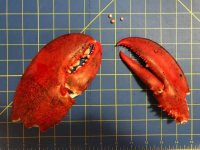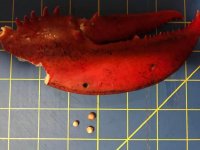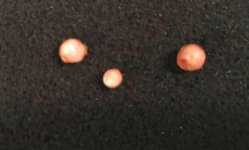Can these type of lab composition tests be performed without damaging the pearl?
No, unfortunately. Or at least not to my knowledge. Gem labs are concerned with nacreous pearls for the most part and only certain species.
Palaentology labs however, are better equipped to provide some insight as to the origin of pearls, but still require a level of conjecture.
Steve brought up an important point, whether the pearl has the characteristics of a molluscan shell or that of an exoskeleton. Calcium versus keratin. There are a couple of field tests you might try, which can help us come to a better conclusion.
Drop the pearl in a glass of water. Does it sink rapidly and touch bottom with a "tink" or does it drop slowly and touch softly? The former could indicate calcium and the latter protein.
Also, run it across a tooth. Does it feel gritty (calcium) or smooth (protein)?
Do you recall what part of the lobster yielded the pearl? Body, legs/claws or tail? Crustaceans tend to be aggressive scavengers and as such are not beneath fighting for survival. Punctures and cracks in the carapace or extremities often occur and tend to heal quite quickly, because they molt their entire shell several times in their lives. It is possible a parasite found a point of entry, in which case "candling" might reveal it. In the absence of a nucleus, it's possible the pearl was created spontaneously, whether by stress or genetic anomaly.
Any pearl from an arthropod is rare, but not necessarily uncommon. Though not gem quality, they are certainly unusual and esteemable finds.







